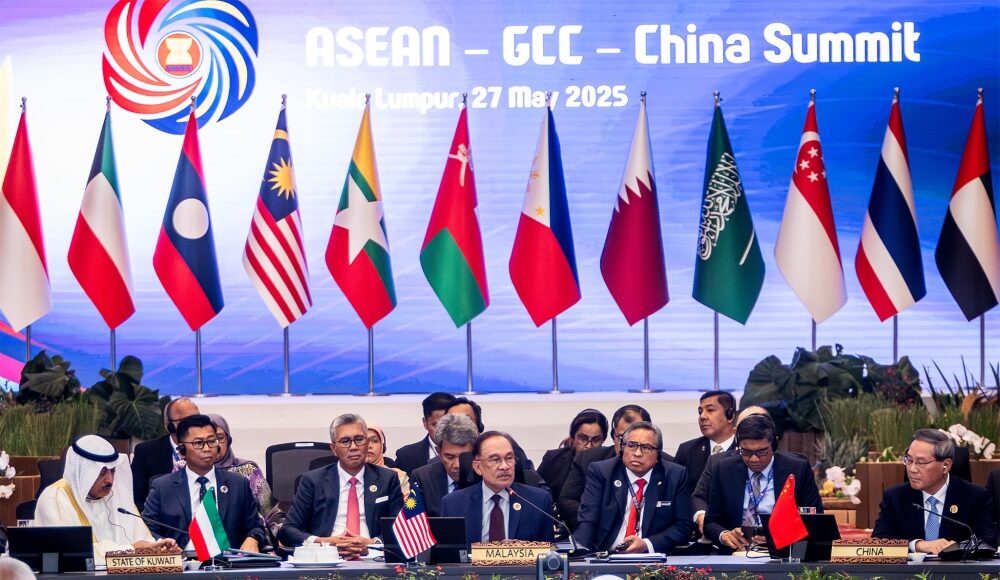MAY 28 — In an era of deepening globalisation, the global economic landscape is undergoing profound transformations, and the international situation has become increasingly intricate.
One certainty is that the trend of global economic integration is irresistible. The economic interdependence among countries continues to deepen, and it is nearly impossible for any nation to achieve sustainable development in isolation.
However, “uncertainties” are emerging, adding many variables to the development of the world economy.
In recent years, the power games among major countries have become increasingly intense, which has had a profound impact on other countries, especially developing ones.
In the trade arena, frequent adjustments to trade policies and the continuous increase of trade barriers among major countries have severely impacted the export markets of developing countries.
Some developing countries mainly export labour-intensive products.
Measures such as tariff hikes and the establishment of technical standards by major powers have led to a decline in the competitiveness of these countries’ products in the international market, a significant drop in export volumes, and many related enterprises are facing survival challenges.
In terms of investment, the geopolitical competition among major powers has changed the direction of international capital flows, making it more difficult for developing countries to attract foreign investment.
The funds originally intended for infrastructure construction and industrial upgrading in developing countries have shifted to other regions due to the uncertainties brought about by the power games among major powers, undoubtedly hindering the economic and development process of developing countries.
The instability of the global economy has also brought many challenges to developed and developing nations.
The slowdown in global economic growth has directly led to a contraction in international market demand, leaving developing countries with insufficient impetus for economic growth.
Under the influence of fluctuations in the global financial market, emerging-market currencies face huge depreciation pressures, further exacerbating the risk of domestic inflation and increasing the cost of living for the people.
Against this backdrop, developing countries urgently need a new mindset and seek ways to break through the Vuca (Volatile, Uncertain, Complex and Ambiguous) environment through continuous development and integration.
In this context, the cooperation among Asean (the Association of Southeast Asian Nations), GCC (the Gulf Cooperation Council), and China is of particular significance.
This cooperation, based on the sustainability and inclusiveness of globalisation, provides new options and paths for regional development and even the reshaping of the world pattern.
The following will delve into the cooperation paths and broad prospects of the three parties in fields such as artificial intelligence (AI), healthcare, and other key areas.
I. Cooperation in the field of artificial intelligence
(I) Synergy in technology research and development
Data sharing and integration:
Asean countries possess abundant data resources in marine fisheries, agriculture, and other fields.
GCC countries have amassed a large amount of data in energy extraction, urban management, etc.
Meanwhile, China has accumulated massive data during the digital transformation of Internet applications and manufacturing.
The three parties can establish a secure data-sharing platform.
Under the premise of complying with each country’s data-protection regulations, they can integrate data from different fields.
For example, in the field of marine fisheries, Asean countries can provide fishing data, China can share intelligent monitoring data of fishery aquaculture, and GCC countries can contribute data on marine ecological environment monitoring, jointly facilitating the research and development of an intelligent monitoring and sustainable development model for marine fisheries.
Pooling of scientific research:
China has advanced technologies and a large number of scientific research talents in AI algorithm research and chip development.
Asean countries have unique advantages in application research such as language processing and image recognition to meet local needs.
GCC countries, with their financial strength, can support the upfront investment in large-scale scientific research projects.
The three parties can jointly establish an AI scientific research fund to finance cross-regional research teams and jointly tackle key challenges such as the optimisation of basic AI algorithms and the construction of general-purpose AI models.
For instance, when dealing with the problem of traffic flow prediction in smart city construction, research teams from the three parties can combine their respective technologies and experiences to develop a more accurate prediction model.
Prime Minister and Asean 2025 Chair Datuk Seri Anwar Ibrahim speaks during the Asean-Gulf Cooperation Council (GCC)-China Summit at the Kuala Lumpur Convention Centre yesterday. — Picture by Firdaus Latif.
(II) Cooperation in application
Upgrading of intelligent manufacturing:
As a major manufacturing country, China has rich experience in industrial intelligent transformation.
It can cooperate with the manufacturing bases in Asean countries to apply AI technology to production process optimisation, quality inspection, and other aspects.
At the same time, the funds from GCC countries can be invested in relevant industrial upgrading projects to help build intelligent factories.
For example, in Malaysia’s electronics manufacturing industry, by introducing China’s intelligent production line management system and with the financial support of GCC countries, both production efficiency and product quality can be enhanced.
Development of intelligent agriculture:
Asean countries are rich in agricultural resources, and there is a large amount of undeveloped land in developing countries, but their agricultural production efficiency needs to be improved.
By leveraging China’s agricultural AI technologies, such as drone-based plant protection and intelligent irrigation systems, and combining with the agricultural investment of GCC countries, modern intelligent agriculture demonstration projects can be created.
In the rice-growing areas of Thailand, intelligent agricultural solutions can be promoted.
Through sensors to monitor soil and climate data in real-time, precise fertilisation and irrigation can be achieved, improving both yield and quality.
II. Cooperation in the field of healthcare
(I) Integration of medical resources
Medical technology exchange:
China has achieved remarkable results in the modernisation of traditional medicine and remote medical technology.
Asean countries have unique experiences in the prevention and treatment of tropical diseases, the application of herbal medicine, and the integration of folk-inherited therapies with local herbs.
GCC countries have certain advantages in the research, development, and application of high-end medical equipment.
The three parties can regularly hold medical technology exchange forums to share the latest research findings and clinical experiences.
For example, the combination of China’s traditional Chinese acupuncture and moxibustion technology and the traditional herbal medicine therapies of Asean countries can conduct joint research on the treatment of chronic diseases.
The integration of advanced medical imaging equipment from GCC countries and China’s remote diagnosis technology can improve the efficiency of medical diagnosis.
Medical talent training:
A regional joint medical talent training mechanism can be established.
Chinese medical colleges and universities can cooperate with their counterparts in Asean and GCC countries to carry out exchange student programmes and joint training courses.
Professional talents can be trained in fields such as infectious disease prevention and control and public health emergency management.
For example, Chinese medical colleges can offer practical courses on infectious disease prevention and control for medical students from Asean and GCC countries, allowing them to participate in actual epidemic prevention and control drills and enhancing their ability to respond to public health incidents.
(II) Cooperation in public health
Joint prevention and control of diseases:
In the context of globalisation, the risk of cross-border transmission of infectious diseases has increased.
The three parties should establish an infectious disease information-sharing mechanism to promptly report epidemic situations.
They can jointly carry out vaccine research and development cooperation.
By leveraging China’s vaccine research and development technology, the virus sample resources of Asean countries, and the financial support of GCC countries, their ability to respond to newly emerging infectious diseases can be enhanced.
For example, during the COVID-19 pandemic prevention and control, the three parties strengthened cooperation, shared virus gene sequence data, and jointly carried out vaccine clinical trials to improve the effectiveness and applicability of vaccines.
Construction of grassroots health systems:
The grassroots and basic health systems in some regions of Asean countries are weak.
China has rich experience in building grassroots medical and health service systems and can help Asean countries improve the layout of grassroots medical facilities and train grassroots medical staff.
GCC countries can provide financial assistance to support the informatisation construction of grassroots health institutions, introduce remote medical services, and improve the level of grassroots medical services.
In rural areas of Cambodia, digital grassroots medical stations can be built, connecting local residents with Chinese medical experts through telemedicine to provide high-quality medical services.
III. Cooperation in other fields
(I) The field of green energy
Development of renewable energy:
Asean countries are rich in solar, wind, and hydropower resources.
China is a world leader in the research, development, and equipment manufacturing of renewable energy.
GCC countries have extensive experience in the capital operation and infrastructure construction of the energy industry.
The three parties can cooperate to develop large-scale renewable energy projects.
For example, in the construction of offshore wind power projects in the Philippines and Vietnam, China can provide wind turbine equipment and installation technology, Asean countries can provide sites and labour, and GCC countries can invest funds and participate in project management to jointly promote energy transformation.
Innovation in energy technology:
Joint research and development of key technologies such as energy storage and smart grids can be carried out.
Chinese scientific research institutions and enterprises can cooperate with relevant units in Asean and GCC countries to overcome the intermittency problem of renewable energy and improve energy utilisation efficiency.
For example, in the construction of a smart grid demonstration project in Saudi Arabia, by introducing China’s advanced grid management technology and combining it with local energy demand characteristics, efficient energy distribution and utilisation can be achieved.
(II) The field of digital economy
Construction of digital infrastructure:
China has advanced technologies in 5G communication and fibre-optic network construction and can help Asean countries improve the level of digital communication infrastructure.
GCC countries can invest in relevant projects to promote regional digital connectivity.
In the JS-SEZ economic and free trade zone on the border between Singapore and Malaysia and in Kuala Lumpur, the capital city of Malaysia, high-speed broadband networks and 5G base stations can be built to support cross-border digital trade and industrial cooperation.
E-commerce cooperation:
China has a mature e-commerce model.
Asean countries have rich resources of characteristic products, and GCC countries have a large potential consumer market.
The three parties can build cross-border e-commerce platforms to promote the circulation of goods.
For example, in the UAE, an Asean–China commodity exhibition centre can be established.
Through the combination of online e-commerce platforms and offline exhibitions, agricultural products and handicrafts from Asean and manufacturing products from China can be promoted to the GCC market.
At the same time, high-end consumer goods from GCC countries can be introduced into the Chinese and Asean markets.
The cooperation among Asean, GCC, and China has great potential in many fields such as artificial intelligence, healthcare, and others.
Through comprehensive and multi-level cooperation, it can not only enhance the development levels of countries within the region but also provide a successful example for regional cooperation in the context of global instability.
It will lead people to make steady progress in economic, social, scientific, and technological aspects, and jointly build a more prosperous, inclusive, and sustainable regional development pattern, which is also the core appeal of this Asean–GCC–China conference.
* KP Chiew is the secretary-general of the One Belt One Road Economic Friendship (Obor) Association
** This is the personal opinion of the writer or publication and does not necessarily represent the views of Malay Mail.





